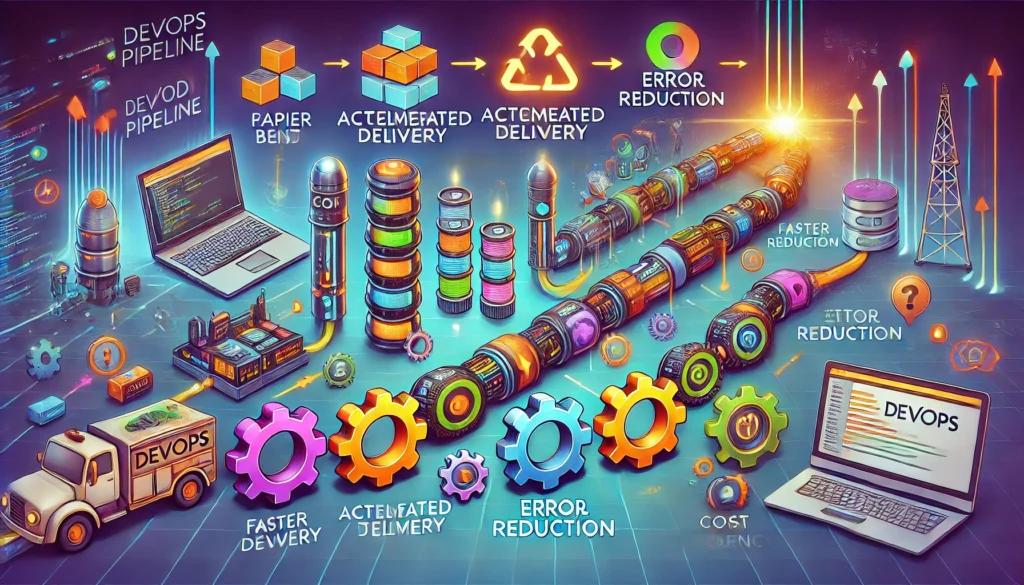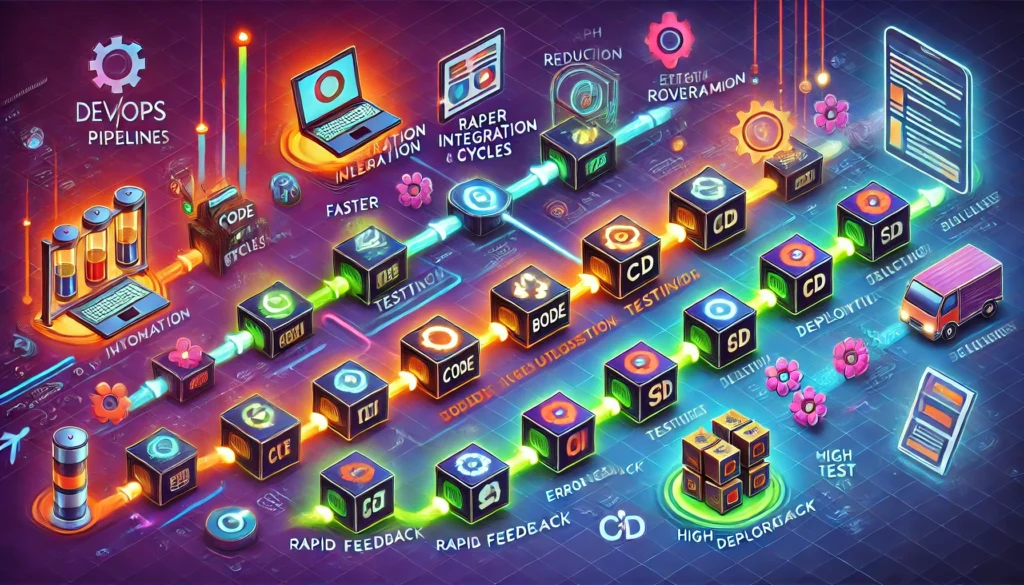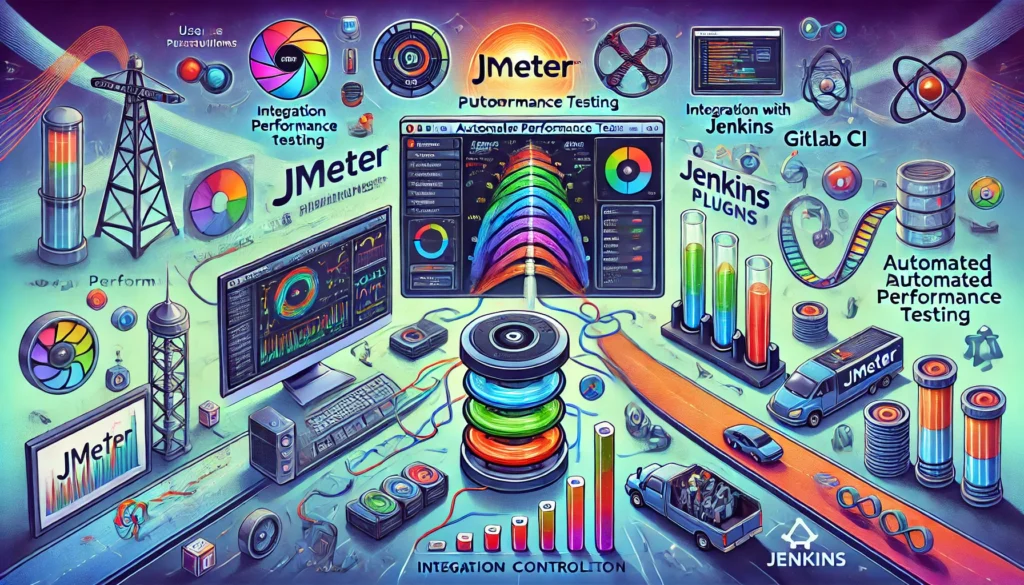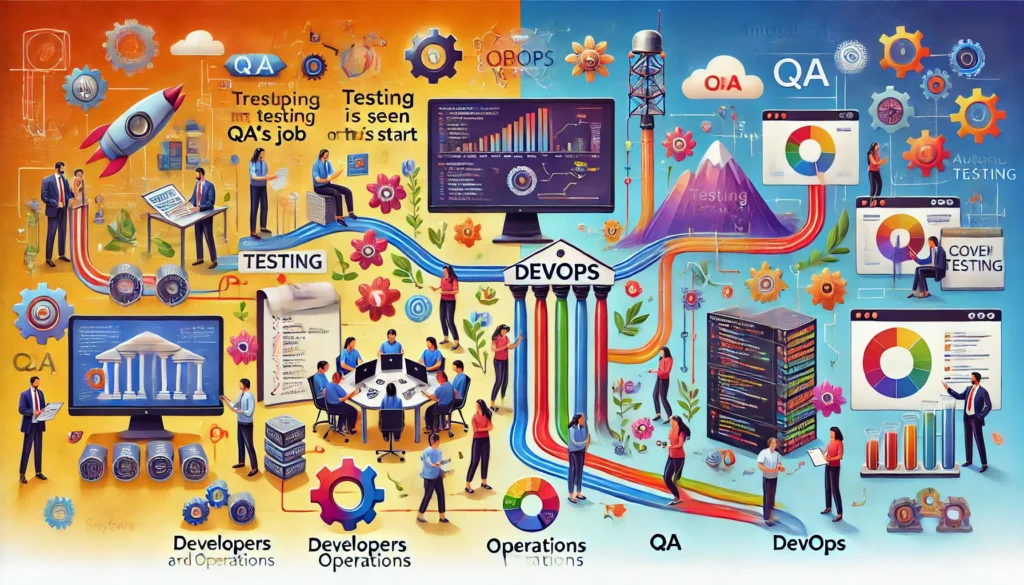Quality assurance automation: Advanced techniques within DevOps pipelines

Quality assurance automation is essential for accelerating software delivery in DevOps. As organizations push for faster releases and higher-quality software, incorporating automated testing into the DevOps pipeline enhances both efficiency and reliability. Traditional testing methods struggle to keep up with modern applications, especially those using microservices and APIs, which require more advanced techniques to ensure seamless integration.
Key methods like shift-left testing, continuous testing, and AI-driven approaches are now reshaping quality assurance. These strategies help detect issues early, reduce defects in production, and improve resource management.
This article explores:
- Shift-left testing. Testing early to catch and fix defects faster.
- Continuous testing. Quality assurance automation throughout development for immediate feedback.
- Test automation frameworks. Using robust frameworks for reusable, maintainable test scripts.
- API testing. Ensuring smooth communication between microservices through automated API tests.
- Cloud-based testing. Leveraging cloud infrastructure for scalable, flexible testing.
Test automation: Your way to achieve operational excellence
- Quality assurance automation: Advanced techniques within DevOps pipelines — you are here
- Optimizing AWS DevOps: Strategies for Seamless Infrastructure Management
The evolution of quality assurance automation in DevOps
The shift to DevOps
DevOps has redefined software development by fostering collaboration between development and operations teams, prioritizing automation, rapid iteration, and continuous feedback to streamline software delivery.
- Collaboration and communication. DevOps unites developers and operations, breaking silos and promoting shared tools and responsibilities. This approach speeds up issue detection and resolution, ensuring more reliable software releases and faster adaptation to evolving requirements.
- Continuous testing. Quality assurance automation in DevOps is integrated throughout development, ensuring every code change is automatically tested. This reduces the risk of defects in production and provides immediate feedback, allowing quicker fixes.
Challenges of traditional testing in DevOps
- Delayed feedback. Traditional testing, often done post-development, slows feedback and introduces bottlenecks, delaying projects and increasing costs.
- Manual effort. Manual testing is time-consuming and prone to errors, becoming less feasible as software grows more complex.
- Inflexibility. Traditional methods struggle to keep pace with rapid, continuous integration, making them ineffective in fast-moving development environments.
The importance of quality assurance automation in DevOps pipelines

How automation drives CI/CD
Automation is the core of DevOps, streamlining code integration, testing, and deployment.
- Accelerated delivery. Automation enables faster integration, build, and test cycles through Continuous Integration (CI) tools, while Continuous Delivery (CD) ensures reliable, frequent deployments.
- Error reduction. Automating repetitive tasks like testing and deployment reduces human error and ensures consistent processes across the pipeline.
Quality assurance automation role in quality and speed
- Rapid feedback. Automated tests give immediate feedback on code changes, allowing teams to fix issues quickly and avoid escalation.
- Higher coverage. Automation allows broad test coverage across various environments, catching defects that manual testing would miss.
- Cost efficiency. While initially expensive, automated testing lowers long-term costs by preventing defects and reducing manual efforts.
Advanced techniques in quality assurance automation
AI and machine learning in test automation
Once traditional testing relies on manual test case generation and maintenance, often leading to time-consuming processes and error-prone scenarios, AI-powered tools act differently:
- Test case generation. Instead of manually creating test cases based on user stories and code, AI analyzes these inputs to automatically generate comprehensive tests, ensuring broader coverage and fewer manual mistakes.
- Execution and maintenance. While traditional testing often struggles to prioritize or update test cases as the code evolves, AI identifies high-risk areas and automates updates, keeping the test suite current and reducing unnecessary efforts.
- Self-healing tests. Unlike traditional tests, which require manual intervention when the UI changes, AI-driven tests adapt on their own, significantly cutting down on maintenance time.
- Predictive analytics. Instead of waiting for defects to surface in testing, AI leverages historical data to predict potential issues, allowing teams to proactively fix them before they impact production.
Examples of AI-powered tools:
- Testim. Uses machine learning to create and maintain tests.
- Applitools. Validates visual consistency across browsers with AI.
- SeaLights. Optimizes testing by running only high-risk tests based on AI analysis.
Performance QA automation
Automating performance testing is crucial for ensuring scalability and handling real-world user loads.
- Tools. Popular tools like JMeter and Gatling simulate user traffic to test system performance under different conditions. JMeter is known for its plugins and ease of use, while Gatling excels in resource efficiency.
- Scalability testing. Automated performance tests simulate real-world traffic, identifying bottlenecks early to prevent issues post-deployment.
Testing microservices and serverless architectures

Microservices and serverless architectures present unique challenges, such as ensuring seamless communication, state consistency, and handling dynamic scaling.
- Contract testing. Ensures reliable interaction between services by verifying that they follow agreed-upon contracts.
- Service virtualization. Simulates unavailable or costly-to-invoke services for more comprehensive test scenarios.
Tools for microservices testing:
- Postman: Simplifies API and automated testing workflows.
- WireMock: Mocks dependent services for testing in DevOps pipelines.
- Spring Cloud Contract: Validates interactions between microservices through contract testing.
Containerization and orchestration in testing
Technologies like Docker and Kubernetes are critical for creating consistent, reliable test environments.
- Docker: Packages applications with their dependencies in containers, ensuring consistent environments across development and production.
- Kubernetes: Automates container deployment and scaling, simplifying maintenance and ensuring consistency for automated tests.
Shift-left and shift-right testing
- Shift-left testing focuses on early testing during development to catch defects sooner. Benefits include faster feedback, better code quality, and lower costs for bug fixes.
- Shift-right testing, in its way, Involves testing in production environments, monitoring real-world performance post-deployment. Techniques like A/B testing, chaos engineering, and user feedback ensure applications adapt to real-world conditions.
Tool-specific implementations in DevOps
Selenium vs. Cypress in DevOps pipelines
When considering automated UI testing within DevOps, Selenium and Cypress stand out as prominent options, each catering to different project needs. Selenium, known for its versatility, supports various programming languages such as Java, C#, Python, and Ruby, making it a strong fit for teams working across multiple tech stacks.
It operates remotely via the WebDriver protocol, offering comprehensive cross-browser testing capabilities. In contrast, Cypress is tailored for JavaScript applications and runs directly within the browser. This approach not only improves test accuracy but also enhances speed, especially for modern frameworks like React and Angular.
Usability
In terms of ease of use, Cypress tends to outshine Selenium. Its simple API and built-in utilities make writing and maintaining tests easier, while its real-time execution feedback and debugging tools streamline the testing process. Meanwhile, Selenium, though flexible, often requires more setup and configuration, leading to a steeper learning curve, particularly when dealing with cross-browser testing.
Performance
Performance-wise, Cypress generally executes tests faster because it interacts directly with the application, bypassing the network overhead seen in Selenium’s remote browser control. However, both tools, when optimized, can deliver strong performance.
Integrations
Both Selenium and Cypress integrate well with CI/CD pipelines using tools like Jenkins or GitLab CI. Selenium requires a bit more configuration, often involving setting up a Selenium Grid for cross-browser testing. Cypress, with its simpler integration and features like screenshots and video capture, provides a more straightforward setup, especially in handling debugging within CI pipelines.
Implementing Appium for mobile quality assurance automation in DevOps
As mobile applications grow, integrating Appium into DevOps becomes crucial. Appium, supporting iOS and Android, allows teams to automate mobile tests in languages like Java, Python, or JavaScript. Setting up Appium involves configuring devices or emulators and creating modular, reusable test scripts. Integration with Jenkins or GitLab CI automates mobile testing, with plugins and Docker containers simplifying the process.
Mobile testing presents challenges, particularly in managing multiple devices, flaky tests, and ensuring consistent environments. Cloud-based services like Sauce Labs or BrowserStack help address these by offering access to a broad range of devices without the need to manage them physically. Parallel test execution and robust test design with retry logic also mitigate these issues.
Using JMeter for automated performance testing

For performance testing, JMeter plays a key role in DevOps pipelines. Teams can design test scripts using JMeter’s GUI, defining user loads and metrics to monitor. Storing these scripts in version control enables collaboration, while integration with Jenkins or GitLab CI automates performance tests post-build. Reporting and visualization tools, such as Grafana, help analyze performance trends and identify potential bottlenecks. Jenkins plugins further enhance reporting and support parallel execution of JMeter tests.
With Selenium, Cypress, Appium, JMeter, and other similar tools, DevOps teams can create robust, efficient, and comprehensive testing strategies, seamlessly integrated into CI/CD workflows. Each tool brings unique strengths, allowing organizations to tailor their testing approaches to specific needs while maintaining high-quality software releases.
Continuous testing and monitoring in DevOps
Continuous testing is a key aspect of DevOps, ensuring that testing is integrated at every stage of development. Rather than waiting for final stages to validate code, testing becomes a continuous process, validating every code change and helping teams maintain high-quality software in fast-paced environments.
Testing throughout the pipeline
Continuous testing involves running automated tests from the start, beginning with unit tests during coding and extending to integration and acceptance tests before deployment. This approach catches defects early, reducing the chances of issues arising in production, and streamlines the release process.
Boosting code quality and minimizing defects
By embedding automated tests in the CI/CD pipeline, teams receive rapid feedback on code quality. This allows developers to address problems as soon as they appear, enhancing overall code quality. The proactive identification of issues also reduces the number of defects reaching production, ultimately cutting down the costs of bug fixes later in the cycle.
Continuous monitoring and feedback loops
Monitoring tools provide real-time insights into how applications perform in production and how users interact with them, complementing continuous testing by offering ongoing feedback.
Using data to optimize performance
Monitoring tools gather data such as test execution results, performance metrics, and user interaction data. Teams can analyze these insights to detect trends and identify anomalies, enabling them to make data-driven decisions to enhance reliability and performance.
Dashboards and real-time alerts
Optimizing quality assurance automation with analytics
Analytics can significantly improve the efficiency of test automation by highlighting bottlenecks and optimizing the test suite.
Pinpointing inefficiencies and refining test suites
By analyzing test execution data, teams can identify areas where tests are slow or prone to failure. This allows them to remove redundant tests or refocus on critical areas, leading to faster test execution and more reliable results.
Tools for test performance insights
Several tools enhance test automation with detailed analytics:
- Allure generates detailed reports on test execution, providing clear visualizations of results.
- SonarQube measures code quality and test coverage, guiding teams to improve coding standards.
- TestRail offers analytics for managing test cases and tracking execution metrics, helping to identify areas for process improvement.
By integrating continuous testing and monitoring, you can release software faster and more reliably. Real-time feedback, combined with the power of analytics, ensures that quality assurance automation is thorough and optimized, paving the way for high-quality releases and robust application performance.
Continuous testing and monitoring
The role of continuous quality assurance automation in DevOps
Continuous testing is a cornerstone of DevOps, essential for maintaining software quality in fast-paced development environments. It ensures that testing is not confined to the final stages of development but is integrated into every phase, from code writing to production deployment.
- Importance of testing at every stage. In continuous testing, automated tests are executed throughout the software development lifecycle (SDLC), from unit tests during coding to integration, system, and acceptance tests before deployment. This comprehensive approach helps identify defects early, minimizing the likelihood of issues surfacing in production environments. The integration of testing at each stage facilitates a smoother release process and enables quick feedback on code quality.
- Improving code quality and reducing defects. Embedding continuous testing into the CI/CD pipeline allows for immediate feedback on the impact of code changes. Automated tests quickly validate the functionality and performance of the new code, helping developers to fix issues in real time. This reduces the number of defects that reach production, lowering the overall cost and time associated with post-release bug fixes.
Implementing continuous monitoring and feedback loops
Continuous monitoring complements continuous testing by offering real-time insights into application performance, stability, and user experience post-deployment. It ensures that issues are quickly detected and addressed before they affect end users.
- Using monitoring tools for test data and analytics. Monitoring tools collect data on test execution, system performance, and user interactions throughout the pipeline. This data is crucial for identifying trends, detecting anomalies, and assessing the health of an application. Examples of monitoring tools include Prometheus for system metrics, Grafana for visualizing performance data, and New Relic for monitoring user experience.
- Dashboards and alerts for real-time feedback. Dashboards help teams visualize key performance indicators (KPIs) such as test pass rates, response times, and system load. Alerts can be configured to notify team members when predefined thresholds are breached (e.g., slow response times or system failures), allowing for immediate attention and resolution before issues escalate.
Enhancing quality assurance automation with analytics
Analytics plays a crucial role in improving test automation by helping teams identify inefficiencies, optimize test coverage, and streamline processes.
- Identifying bottlenecks and optimizing test suites. By analyzing test data, teams can identify bottlenecks in test execution—such as tests that take longer than expected or tests that fail frequently. This insight enables teams to optimize their test suites by removing redundant tests, focusing on critical areas, or adjusting execution schedules for better efficiency.
- Tools for insights into test performance and coverage. Various tools provide analytics to enhance test automation:
- Allure. A reporting tool that generates detailed insights into test execution results, helping teams track test performance and identify areas that need improvement.
- SonarQube. Analyzes code quality and test coverage, highlighting areas that require attention to ensure better code health and maintainability.
- TestRail. Offers test case management and analytics, helping teams track test progress, execution rates, and coverage, enabling better decision-making on test strategy and areas of focus.
Best practices for advanced automated testing in DevOps
Automated testing is a game-changer in DevOps, but it's not something you can just set up and forget. It’s all about continuous collaboration, overcoming common hiccups, and keeping pace with the latest tools and trends. Here’s how you can take your automated testing game to the next level in a DevOps environment.
Integrating testing into the DevOps culture

In a traditional setup, testing was often thought of as “QA’s job.” But in DevOps, testing—and more importantly, quality—is everyone’s responsibility. Developers, operations, and QA teams need to work hand-in-hand to ensure that testing is baked into the process from day one.
This mindset shift toward shared responsibility for quality means that testing isn’t left for the end when things are already going wrong. Instead, automated tests run continuously with each code change, flagging issues early and giving everyone a chance to fix things before they escalate. This is the beauty of continuous testing—it helps prevent nasty surprises during deployment.
The key to success here is communication. When teams communicate openly, bugs get caught faster, and solutions are found quicker. Everyone is on the same page, which ultimately leads to smoother, more reliable software releases.
Addressing common challenges
That said, automated testing isn’t without its challenges. You’ve probably run into a few of these yourself, like tests that pass one minute and fail the next for no apparent reason. These are called flaky tests, and they can really undermine your confidence in the whole process.
One way to deal with flaky tests is to implement retry logic—basically, rerunning tests to see if the failure was a one-off fluke or a real issue. Also, regularly tweaking and improving your test scripts helps make them more reliable over time.
Another common hurdle is environmental inconsistencies. If the environment your developers are working in isn’t identical to the one used in testing or production, you’ll inevitably run into issues. Using containerization tools like Docker can help here by ensuring all environments are the same. This keeps things predictable and minimizes those "works on my machine" moments.
Lastly, there’s the matter of resistance to change. Let’s face it, people get comfortable with their existing tools and workflows, and adopting new ones can feel like an uphill battle. The trick is to promote a growth mindset within your team. By offering ongoing training and showing how much time and effort automation can save, you can ease them into it. Once they see the benefits, the resistance tends to fade.
Continuous improvement and learning
Automation isn’t a “set it and forget it” kind of deal. The world of DevOps is constantly evolving, and if you’re not keeping up, you’ll fall behind. That’s why continuous improvement is so important.
Encouraging your team to keep learning—whether through training sessions, workshops, or simply sharing new insights with each other—keeps everyone on top of their game. There’s always something new to discover, whether it's a shiny new testing tool or an industry trend that’s about to shake things up.
And let’s not forget about staying current with industry trends. Following thought leaders, attending webinars, or even just reading the latest blog posts on automated testing can help your team stay competitive. It’s about being proactive, not reactive. The more agile you are, the better equipped you’ll be to handle whatever challenges come your way.
Case studies and real-world examples
Real-world case studies offer valuable insights into how organizations are leveraging advanced testing strategies to improve their DevOps pipelines. From AI-driven testing to performance testing automation, these examples demonstrate the tangible benefits of integrating modern tools and practices into DevOps environments.
Successful implementation of AI-driven testing in DevOps
One standout example of AI-driven testing in DevOps comes from Microsoft, specifically within their Azure DevOps pipeline. As a leader in software development and cloud computing, Microsoft sought to enhance the speed, efficiency, and reliability of its software delivery processes by integrating AI testing tools.
Challenges faced:
- Data quality and availability. AI algorithms require high-quality, comprehensive datasets to function effectively. Microsoft faced challenges ensuring that the data available for training AI models was clean and representative of real-world use cases.
- Integration complexity. Incorporating AI-driven tools into the existing DevOps workflow wasn’t a straightforward process. Significant adjustments were needed to accommodate AI models, especially when it came to their interaction with legacy systems.
- Cultural shift. Perhaps the most significant challenge was the cultural change required to get teams on board with AI. This meant providing training and fostering an open mindset toward adopting AI-driven methodologies, which represented a substantial shift from traditional testing methods.
Benefits achieved:
- Enhanced testing efficiency. By automating test case generation and execution through AI-powered tools, Microsoft dramatically reduced the time required for testing cycles. This allowed them to release updates more frequently while maintaining high quality.
- Predictive analytics. AI tools were also employed to analyze historical data and predict potential issues before they occurred. This proactive approach helped minimize downtime during deployments and reduced the number of post-release bugs.
- Improved code quality. Automated code reviews powered by AI identified vulnerabilities and inefficiencies, improving the overall robustness of their software products. This not only enhanced security but also boosted the reliability of their applications.
Through these improvements, Microsoft’s Azure DevOps pipeline became more efficient and less prone to human error, ultimately leading to faster release cycles and higher-quality software.
Performance testing automation success stories
Performance testing is another crucial element in ensuring the seamless operation of software in a DevOps environment. Here are two examples of organizations that successfully integrated performance testing into their CI/CD pipelines, achieving measurable improvements.
Example 1: Eficode
Background: Eficode, a DevOps consultancy, recognized the importance of performance testing in ensuring the smooth delivery of software updates. By embedding automated performance tests into their CI/CD processes, Eficode was able to continuously monitor and improve the performance of the software they worked on.
Measurable outcomes:

- Reduced downtime. One of the most significant benefits of Eficode’s approach was a noticeable reduction in downtime during deployments. Automated performance testing allowed them to catch performance bottlenecks early, ensuring smoother transitions between software versions.
- Improved user experience. Continuous performance monitoring meant that issues impacting user experience, such as slow response times, could be identified and resolved before affecting end-users. As a result, user satisfaction metrics improved, and customer complaints related to performance issues decreased.
Example 2: Tricentis
Background: Tricentis, a leader in AI-driven testing solutions, focused on performance testing within CI/CD pipelines to help organizations deliver high-quality software more rapidly.
Measurable outcomes:
- Increased test coverage. By using AI to generate test cases, Tricentis significantly expanded the scope of performance tests. This meant that more scenarios were evaluated, allowing for a more thorough examination of how software would behave under various conditions.
- Faster release cycles. Organizations that adopted Tricentis’s automated performance testing saw a reduction in release cycle times by up to 50%. This allowed for faster deployment of new features and updates, while still maintaining a high level of performance and reliability.
Conclusion
Traditional testing methods can't keep up, which is why advanced techniques like AI-driven testing, performance testing, and continuous monitoring are making a huge difference.
AI-powered testing takes the manual grunt work out of the process, automatically generating and maintaining test cases, and even predicting potential issues before they happen. This helps teams find and fix bugs faster while keeping testing efficient and comprehensive.
Performance testing ensures your software can handle real-world demands. Tools like JMeter and Gatling simulate heavy user traffic, helping you spot bottlenecks early so they don’t become problems down the line.
Meanwhile, continuous monitoring gives you real-time insights into how your software is performing once it's live. With tools like Grafana and Prometheus, you’ll get instant alerts about any issues, allowing you to fix them fast and keep things running smoothly.
Incorporating these advanced techniques into your DevOps workflow isn’t just a nice to have—it’s essential for staying ahead. If you want faster, more reliable software releases now’s the time to embrace AI, automated testing, and continuous monitoring.
Egor Kaleynik
IT-oriented marketer with B2B Content Marketing superpower. HackerNoon Contributor of the Year 2021 Winner – MARKETING. Generative AI enthusiast.
Featured in: Hackernoon.com, Customerthink.com, DZone.com, Medium.com/swlh
More info: https://muckrack.com/egor-kaleynik